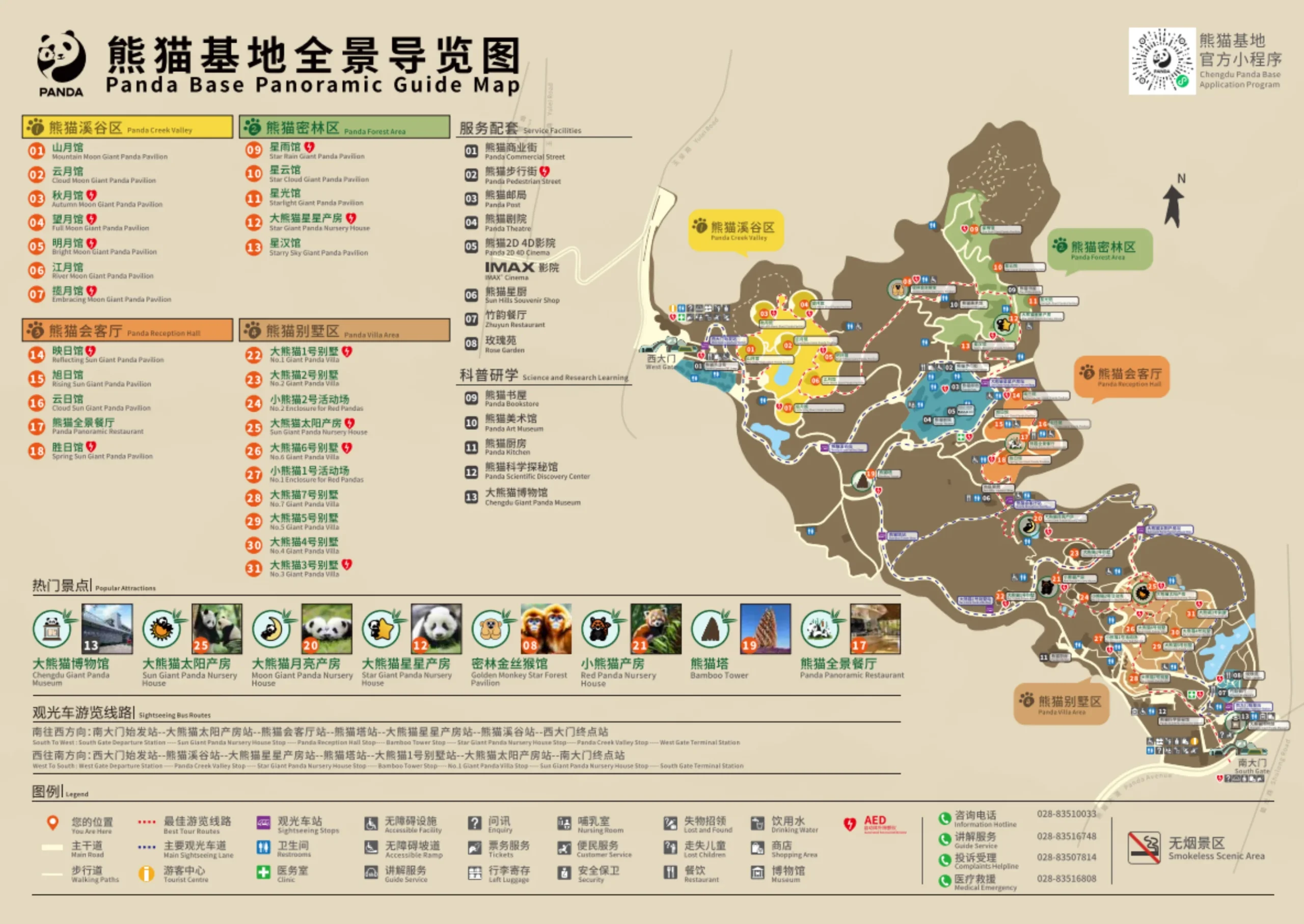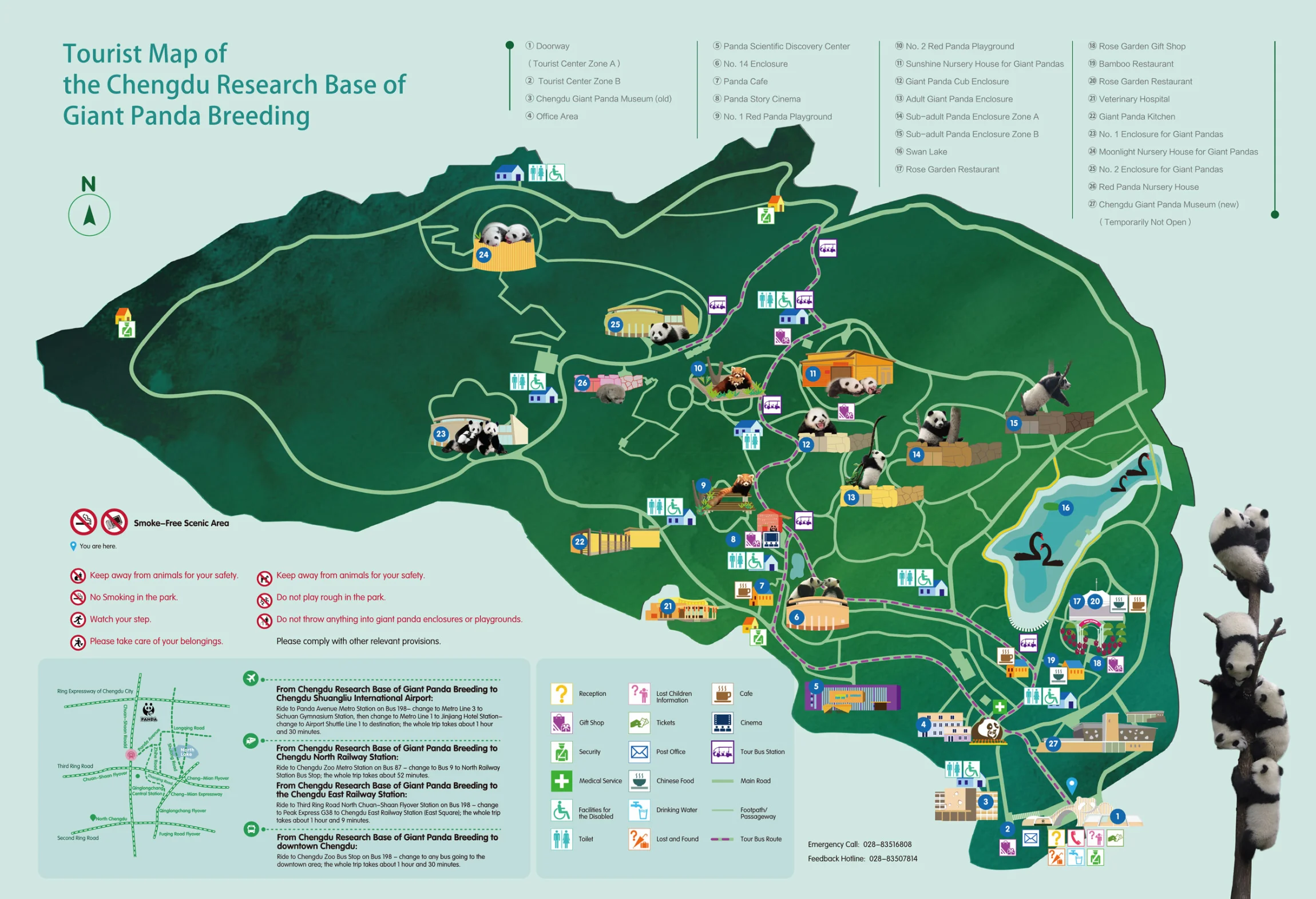Chengdu Research Base of Giant Panda Breeding Map (2024 – 2021)
The most up-to-date Chengdu Research Base of Giant Panda Breeding Map helps you make the most of every moment.
The Chengdu Research Base of Giant Panda Breeding is a conservation and research facility located in Chengdu, China. It focuses on breeding, research, and education to protect the giant panda. The base houses over 100 pandas and includes natural enclosures, nurseries, and visitor education centers.
Spot the best route to the Moonlight Nursery and arrive just in time for a keeper-led feeding. Take a break at the Panda Café near the Sunshine Nursery and recharge before heading to Swan Lake.
Whether you’re chasing baby panda sightings or seeking quiet garden paths, this guide keeps you one step ahead.
Chengdu Research Base of Giant Panda Breeding Map 2024
Chengdu Research Base of Giant Panda Breeding Map 2024 updates include the implementation of a rotational rest system for resident animals, affecting visitor access to certain enclosures. Starting December 25, 2024, the popular “baby giant panda villa” is closed to tourists every Monday to safeguard animal health, and from January 1, 2024, tickets can only be reserved through official channels, not travel agencies. Additionally, the base has enhanced on-site medical facilities for visitors and integrated into the newly established National Giant Panda Conservation and Research Center, which aims to boost research, conservation, and international cooperation efforts.

Printable Chengdu Research Base of Giant Panda Breeding Map PDF 2024
Chengdu Research Base of Giant Panda Breeding Map 2021
Chengdu Research Base of Giant Panda Breeding map in 2021 was the completion of a major expansion project, increasing the base’s area by 169 hectares to a total of 238 hectares. This extension included new panda and red panda houses, with around 40 giant pandas and 10 red pandas moving into the newly built facilities. The expanded area was scheduled to open to the public for test operations in early 2022, offering enhanced visitor experiences and improved habitats for the animals.

FAQ
What can you see at the Chengdu Research Base of Giant Panda Breeding?
At the Chengdu Research Base of Giant Panda Breeding, you can see over 200 giant pandas, rare red pandas, and adorable baby pandas in habitats that mimic their natural environment. The base features special nurseries where visitors can observe baby pandas learning to crawl, as well as celebrity pandas in spacious enclosures. The site also offers opportunities to view pandas up close, take photos (without flash), and explore lush gardens and scenic landscapes.
How does the Chengdu research base contribute to panda conservation beyond breeding?
The Chengdu Research Base contributes to panda conservation beyond breeding by serving as a hub for education, international cooperation, and genetic resource management. It houses the world’s largest panda sperm bank and a stem cell bank to safeguard genetic diversity, runs successful rewilding programs to reintroduce pandas into the wild, and operates the Giant Panda Museum with interactive exhibits. The base also organizes thousands of science education activities, publishes educational materials, and partners with global institutions to advance panda conservation efforts.
Why is Chengdu famous for pandas?
Chengdu is famous for pandas because it is located at the heart of the giant panda’s natural habitat and is home to the world’s largest panda breeding and research centers. The city’s unique geography, historical culture, and commitment to conservation have earned it the title “homeland of the panda.” Chengdu’s association with pandas is celebrated throughout the city, from its mascot to dedicated attractions and conservation initiatives.
Which is better Chengdu Panda Base or Dujiangyan Panda Base?
Chengdu Panda Base is larger, has more pandas—including many cubs—and is more accessible, making it ideal for first-time visitors and families. Dujiangyan Panda Base is smaller, less crowded, and focuses on panda rescue, disease control, and rehabilitation, offering unique volunteer programs for a more hands-on experience. If you prefer seeing many pandas and cubs in a well-developed setting, choose Chengdu Panda Base; for a quieter visit with opportunities to volunteer, Dujiangyan Panda Base is better.






